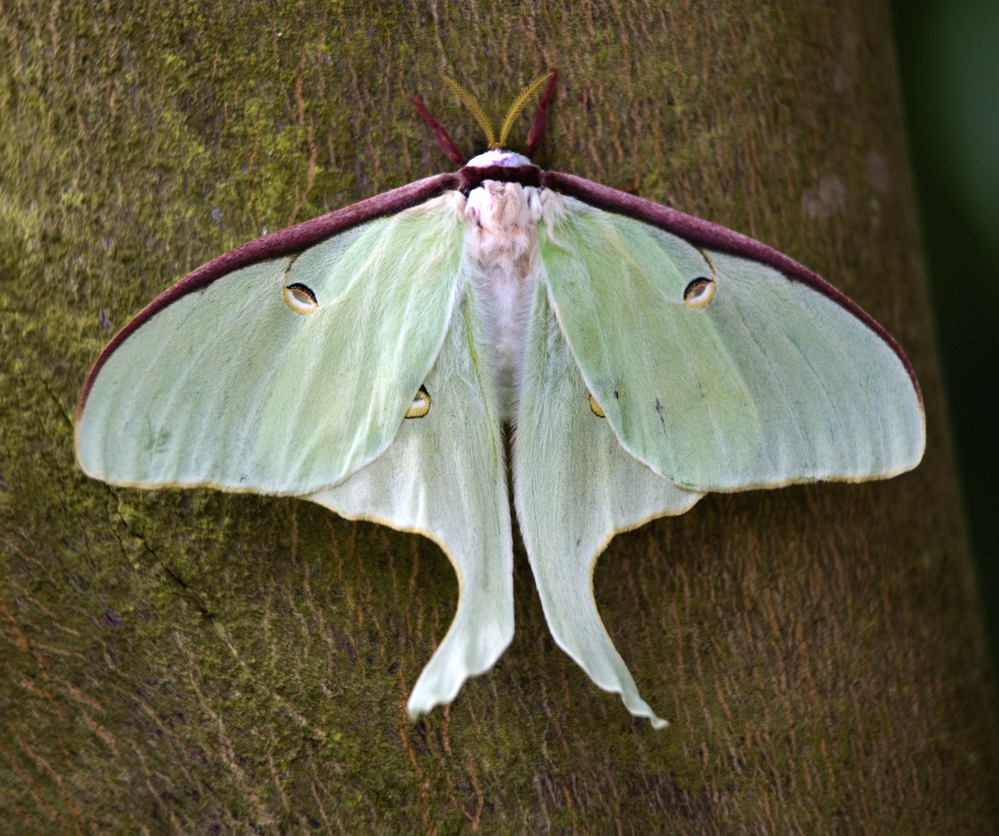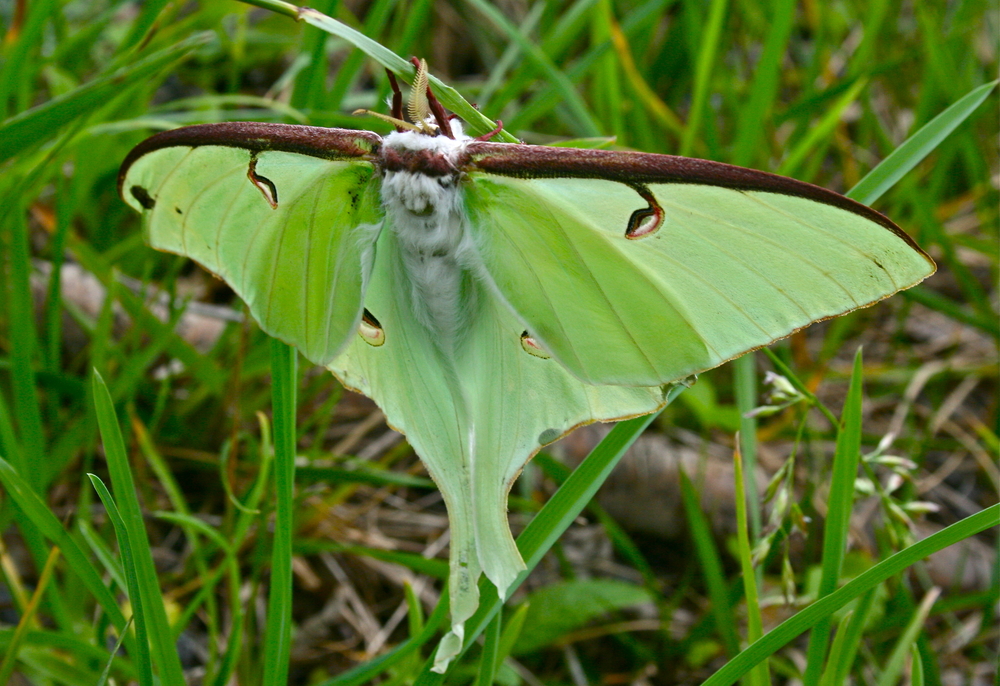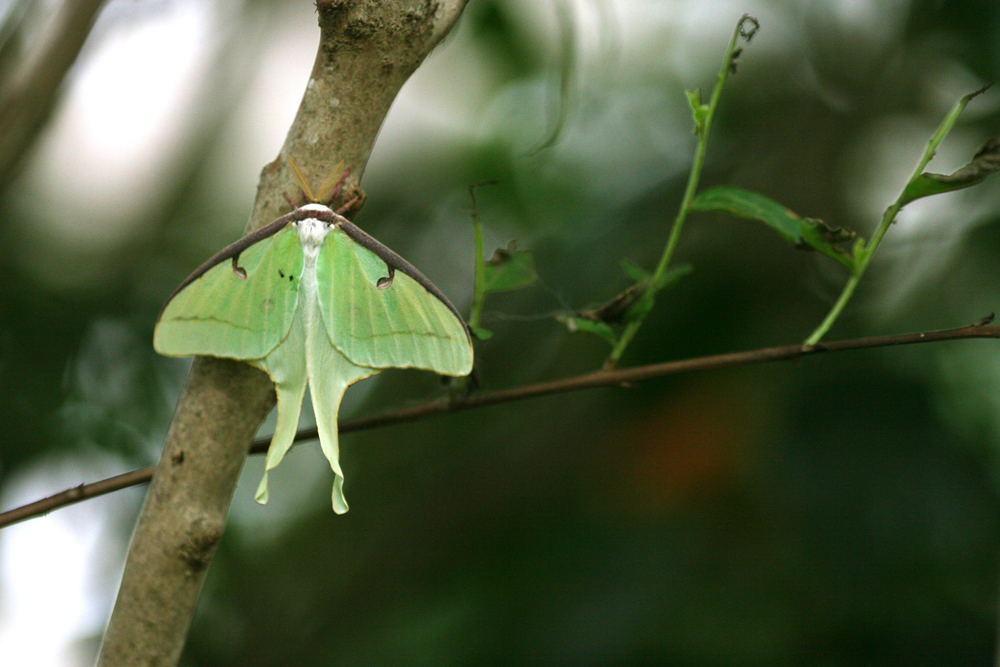The luna moth (actias luna) is one of the largest moths of North America from the family Saturniidae, subfamily Saturniinae, which is a group commonly known as giant silk moths.
Also known as the American moon moth and lunar moth, luna moths are thought to be named after the roman moon goddess, Luna, due to their hindwing spots which look like the moon when it’s nearly full, due to their translucent discs with a dark crescent edge.
Adult luna moths are found in temperate regions of North America, and its range extends into Central America. The adults are nocturnal and are active during the warmer months (late May or early June).
If you were to see a luna moth flying in a temperate forest during the daytime, it would likely be too dark for you to observe its colours, but there is one colour that stands out from the rest: green! This colouration of the moth has earned it common names like moon moth or golden tiger because some people find it difficult not to stare at this bright, beautiful creature fluttering all around them while they walk through a forest outdoors.
The Caterpillar
The luna moth is common in many areas of North America, and its larvae cause damage to forests. These caterpillars feed on various species of tree leaves, including hickory, walnut, American sweet gum, and paper birch trees. In northern regions, the caterpillar loves to feed on white birch.
The larva is a pest in forest habitats because it will defoliate trees by cutting their leaves away from the trunk. The larva has a special long tongue that cuts into the bark when it eats through the bark below it. The feeding pattern is very regular, beginning at the edges of the tree trunks and moving towards the centre.
Luna moth larvae are a major problem in forests where the trees are not otherwise managed. This species overwinters as a pupa in a cocoon on branches or trunks of its host.
As a defence mechanism, luna moth caterpillars can emit a clicking sound to deter and confuse predators and regurgitate intestinal contents for the same purpose.
The Moth
The moths have no mouth and thus are very short-lived. The adult luna moth is active for about a week, using its feathery antennae to detect pheromones emitted by females to attract males.
During this week in its adult form, these saturniid moths will have a busy time searching and mating. It does not feed as an adult and must rely on fat stores from its caterpillar stage to survive.

How To Identify A Luna Moth
One of the largest moths in North America, with an adult wingspan of approximately 5-7 inches across, the luna moth’s most distinctive and identifiable features are its long hindwing tails.
Male and female luna moths are similar in size and appearance, typically with lime green wings, and eyespots on both forewings and hind wings. They also have long and somewhat twisted tails extending from the back edge of the hindwings. One way of determining their sex is by looking at the abdomen. As female luna moths produce 200-300 eggs, their stomach is usually larger than the males.
It flies at night and is attracted to lights. Depending on the region and stage in its short life, its wings are often coloured various shades of brownish-yellow or reddish-brown, with yellow patches on both sets of wings near the body.

How To Identify A Luna Moth Caterpillar
Luna caterpillars are active during the day. They can live up to 7 weeks and mature in the fall when they begin to construct a cocoon.
Caterpillars are about 2.8–3.5 inches long, cylindrical, with a pale greenish-brown head. The three dark dorsal stripes running from their head to their base are bordered by white; each stripe is made up of two rows of red patches, with eyespots at the ends of the stripes.

Where Can You See a Luna Moth?
The luna moth is found in North America east of the Great Plains, and its range extends into northern Mexico. It is found in every eastern state, west to eastern Texas, and from Maine south to Florida. It can be found from Canada south through eastern states such as Kentucky and Tennessee to Central America. It is not commonly seen west of the Rocky Mountains due to cooler weather conditions that may stress or kill these moths.
Luna moths are active at night. During the day, they rest in dark crevices on tree trunks or branches. Luna moths can also be found on bark or wood beside trails.
The luna moth is attracted to lights at night. At dusk or dawn, the moths leave and fly to a tree or bush to rest during the day, often directly beneath a light. They are very attracted to yellow light and can be found flying around buildings temporarily at night.

Luna Moth Habitat
The luna moth is most common in forests, mainly deciduous and mixed woodlands, yet unseen on the forest floor. It is particularly fond of yellow poplar and American beech. Luna moths are found in the canopy and middle layers of forests, as well as in suburban and suburban areas. This is due to its host tree selection.

Luna Moth Life-Cycle
The female luna moth lays encapsulated eggs in the bark of trees under her larval stage. The time between laying their eggs and emerging as adults ranges from 10-14 weeks.
The female luna moth lays its eggs in clusters of up to 450 eggs that are fed on until they hatch into caterpillars. The caterpillar forms a cocoon from which adult luna moths emerge after a few days as an adult.
The adult moth has a very short lifespan – approximately one week, during which time it mates, lays eggs and dies.
Sources and References
- Luna Moth – hgic.clemson.edu
- Goddess Of The Moon: The Life History Of The Luna Moth – fllt.org
Sam loves to learn about animals and their habitats. He has been a nature lover from a very young age, and has been writing papers and articles about wildlife for as long as he can remember.
